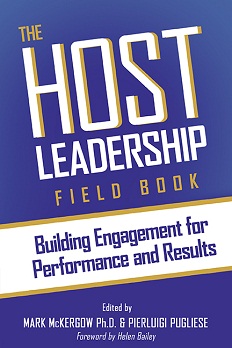I am very excited that my chapter on “Helping engagement with messy experience ..”is published today in the new Host Leadership Field Book.- Please see :The Host Leadership Field Book

Let’s continue..
Host Leadership became a common approach to assess personal approaches to different facilitated intervention planning and preparation of interventions.
In fact Host Leadership is a ladder of facilitative influence and has been used as a check in and check out personal and professional feedback tool.. Through exercises to organize and invite professional and private meetings (for example very complex birthday parties according to the guests and available resources), the participants understood what they had to do as hosts before, during and after the event. The participants had to both give themselves votes and give votes to their abilities and ways of welcoming people and respecting the process. Having the six roles in mind made them reflect on the extent of the possibilities and criticalities to be handled by them directly or by the group. And this became a mirror: first they saw the facilitator in his different roles as a unique figure, then as through a kaleidoscope they saw the various colours and phases of the various colours. The connection of these colours and these roles with specific process phases and / or facilitative techniques was also nice.
The 25 voluntary employees selected to become Key Internal Facilitators made generalised discussion of small group and also plenary processes about leadership as relationship, before starting their own leadership processes evaluation through the six new roles of engagement. For example. let’s imagine a plenary session like a fishbowl conversation that evoked many more memories and details about their roles. One story sparked another.
And then importantly, they were able to write on the wall the messy experience of these roles together in a way that communicated much more. The different roles were put on individual sheets on different walls. After an official description of the individual roles, the participants gave their definitions even more relevant to their current reality. By doing this they rearranged the ideas about what they were doing and saying in plenary (often they said … “we are only able to do this” … or “we are not able to do everything”) and have therefore transcribed the most effective ways to interpret that role, that is, to live it concretely with the public in certain circumstances. Although the focus on a specific project would certainly have given more order, the ideas became clearer and little by little the ways that could be useful were defined, not only as an attitude, but as “activation” of a given process (” Ah..so that time I could do this! “)
They felt able to share their on-the-ground experience in a way that would truly help their colleagues to shift and shape their roles depending on the goal and on the situation. For instance, there was huge amount of understanding about the roles of engagement and about the progress done or not about these. The interaction among the participants told more of the specific style and behaviour and impact done leafing the concrete role to support the community of practice and the target audience.
We compared the roles to some specific IAF competences such as developing working relationships and designing (Connector), preparing for facilitating processes (Initiator and Co-participator), creating a participatory environment (Inviter and Space Creator), and guiding the group to useful outcomes (Gatekeeper) As Connectors the participants created dedicated teams to analyse the customer’s situation together and then design the most suitable process and method, and of course facilitated internal meetings to spread facilitation processes. As Initiators and Co-participators, they used to collect stories and exercises and we invited participants to then find “their best final story” and techniques in the group by dot voting.
All facilitation events were prepared with preliminary meetings by objective definition with the client based on which the most appropriate methodologies. Participants had to commit to participating in planning before and during our seminars. As Inviters and Space Creators the delegates were more aware of the environment settings and took advantage of those settings in a way to improve the group collaboration. Increasing active listening, clarifying conflict resolution, consensus building among team members were all tasks that they achieved by creating a participatory environment. Finally as Gatekeepers they enhanced the focus on what the client wants and needs.
Delegates gave practical examples of using high quality materials and step by step processes to get results with the client choosing appropriate methods. We helped the group to facilitate meetings on the new products process they mentioned during the masterclass.
Then the delegates understood the four ways to dance the host leadership process managing the given information. They matched on scales of how often and how effective they were for each position (in the spotlight, with the guests, in the gallery, in the kitchen) in order to engage participants and themselves better through the performed modes of new thinking and learning we shared together.. They shared together present experiences where they carried out and embodied those roles (why, what, how, when, where, with whom) and also shared proposals to build and embody new roles in the future (examples, suggestions, positive spaces and locations have been shared among the participants). At the end of the masterclass everyone had to give himself assessments as a facilitator and as a leader. One way to do this was therefore to allow people to recognize themselves in at least three or more prevalent roles and discuss them together (including how they didn’t choose other roles). Also the fact of knowing if they were performing well in the spotlight (or how they prepared themselves to be) or they were better prepared being alone (in the kitchen) or with someone .. they became moments of awareness and possibility of future change.
Roles and positions can be chosen, can be defined in groups beforehand or can be covered by someone else if necessary. This was a useful mental and operational order at the end of a journey to reaffirm that everything can be tried by planning it first. It was a revelatory experience, a great photo and map about how to increase their effectiveness.
They had a chance to talk, see and feel what was conveyed between them leading and those stakeholders entering. Picking roles and positions was the main step to encourage the whole group to build shared understanding in another way than in a circle, giving them a map and a new vision for the situations they were facing.
Conclusion
Assimoco has to share the results and the facilitative team spirit in order to accomplish their new challenges. The natural inner transformational changes of the people was fantastic indeed: more engaged with more wisdom about the usage of the methods depending on the target. They told us at the beginning…:”We cannot do and deliver all the stuff you’re sharing”…and at the end they say : “Awesome..and wonderful what we have done together”. And from our perspective we were also surprised by our new capacity to inspire a good fusion of different approaches, respecting the processes and the philosophy behind. When people speak new languages and create new words, it’s the moment you really say :”Aha!” That’s really and truly wonderful.
We encouraged host principles at the beginning and it was clear for us the Host Leadership involves a direct social influence and happens within an organization in different styles.
Style is everything and we know, thanks to Mark and Helen, we have six new styles and super-powers. There is also indeed an empirical evidence that Host Leadership results in a deeper bond between employees and the organization if there is a good facilitative flow.
Only when you pick the appropriate Host Leadership style and role you will be able to facilitate better and better.
